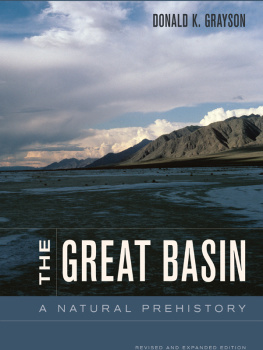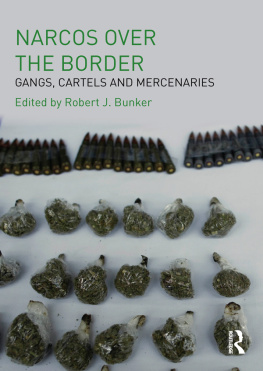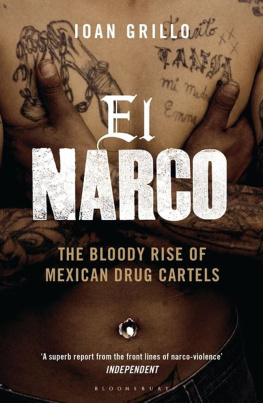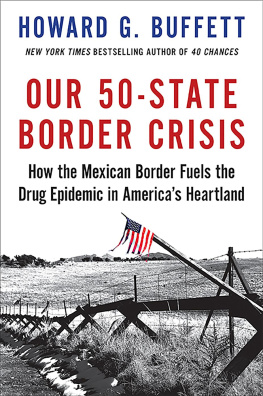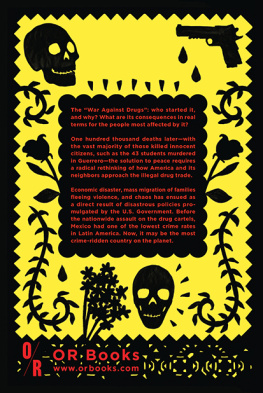

Fifth printing 2011
Copyright 2010 by Transaction Publishers, New Brunswick, New Jersey.
All rights reserved under International and Pan-American Copyright Conventions. No part of this book may be reproduced or transmitted in any form or by any means, electronic or mechanical, including photocopy, recording, or any information storage and retrieval system, without prior permission in writing from the publisher. All inquiries should be addressed to Transaction Publishers, RutgersThe State University of New Jersey, 35 Berrue Circle, Piscataway, New Jersey 08854-8042. www.transactionpub.com
This book is printed on acid-free paper that meets the American National Standard for Permanence of Paper for Printed Library Materials.
Library of Congress Catalog Number: 2009029164
ISBN: 978-1-4128-1151-4
Printed in the United States of America
Library of Congress Cataloging-in-Publication Data
Grayson, George W., 1938
Mexico : narco-violence and a failed state? / George W. Grayson.
p. cm.
Includes bibliographical references and index.
ISBN 978-1-4128-1151-4
1. Drug traffic--Mexico. 2. Narco terrorism--Mexico. 3. Drug control--Mexico. 4. Mexico--Politics and government. 5. Mexico--Economic conditions. I. Title.
HV5840.M4G73 2009
363.450972--dc22
2009029164
Dedication
To Jos Ral Vera Lpez, O.P., Bishop of Saltillo, Coahuila, and to Hctor Gonzlez Martnez, Metropolitan Archbishop of Durango, for your courage in the face of personal danger, your readiness to condemn supposedly untouchable criminals and their enablers, and your inspirational commitment to uplifting the downtrodden.
Contents
Acknowledgments
Upon embarking upon this project, I had no idea of the spider web-like complexity of the drug world. Time constraints and scanty information force television news programs to simplify coverage: Sinaloa Cartel May Resort to Deadly Force in U.S., Mexico Captures Powerful Gulf Cartel Hit Man, and Suspected Cop Killer May Be in Zeta Gang,Details to Follow.
Take, for example, Los Zetas. Trained with U.S. assistance as members of the Mexican Armys Special Forces Airmobile Groups (GAFES), several of these elite soldiers defected to protect the top dog in the Gulf Cartel, headquartered in the Matamoros area, south of Brownsville, Texas; after the incarceration of cartel leader Osiel Crdenas Guilln. The paramilitaries gradually began acting on their own, eventually forging an independent, cellular structure. Yet it is unlikely that the separation is complete. The Gulf Cartel still controls 20 or 30 percent of Tamaulipaswith Los Zetas commanding the rest. The relatively low death toll in this coastal state attests not only to the coziness between local politicians with the narco-barons, but to the probability that Los Zetas and the Gulf Cartel have hammered out a modus vivendi and cooperate occasionally when it serves the interests of both. In southern Guerrero, a Hobbesian state of violence and misery, Los Zetas have cast their lot with the Beltrn Leyva family (former allies of the Sinaloa Cartel) and appear to have done the same in various municipalities of Mexico State, the nations most populous jurisdiction. For a while, the ex-soldiers and their recruits made common cause with one of four segments of the shadowy, messianic La Familia. The syndicate is centered in bloodstained Michoacan state where the Milenio and Jalisco Cartels, comrades of the Sinaloans, long have operated.
Middle East scholar par excellence and a valued colleague at the College of William and Mary, James Bill, analogizes Mexicos drug world to Afghanistan, Pakistan, and Iraq. Political parties and their armies may dominate the headlines. A closer look, however, finds religious, ethnic, and linguistic factions suffusing these organizations. Then there are regional and sub-regional groupings within which exist tribes and warlords, who may or may not speak for extended families that have their own agendas. One is reminded of matryoshki , the Russian nesting dolls of decreasing sizes, one placed inside the other.
The challenge of conducting research on Mexicos underground also springs from cartel members employing multiple names; their readiness either to take credit for operations they did not commit or to blame rivals for those that they did; and the obvious barrier to talking with culprits and suspects. Moreover, President Felipe Caldern Hinojosas local version of the war on drugs had produced the arrest of hundreds of narco-traffickers in 2009, often sparking changes in the leadership and structures of criminal syndicates. A moving picture would be more useful, but the author can present only his snapshot of the syndicates, cartelitos , gangs, and freelance thugs.
For this reason, I admire authors of articles, reports, and books that have brought clarity, insights, and a framework to the subject at hand.
Among these astute individuals are Sigrid Arzt Colunga, Luis Astorga, Bruce M. Bagley, Abel Barajas, John J. Bailey, Charles Bowden, William Booth, Edgardo Buscaglia, Mark Bowden, Hal Brands, Tracy Carl and her colleagues at the Associated Press in Mexico City, Jorge Chabat, James H. Cheechan, Ron Chepesiuk, Hugh Collins, A.J. Corchado, Sam Dillon, Ken Ellingwood, Jess Esquivel, Samuel Gonzlez Ruiz, Jos Gil Olmos, Tim Golden, Dan Gretch, Ion Grillo, Alejandro Gutirrez, Enrique Krauze, Mark Lacey, and Sam Logan.
Other experts include Peter A. and Kip Schegel Lupsha, Adela Navaro Bello and her colleagues at the Zeta news weekly, Terrence Popper, Julia Preston, Sam Quiones, Ricardo Revalo, Luis Rubio, Julio Scherer Garca, Diana Washington Valdez, Casey Wian, and scores of other careful observers. Although I have talked directly with more than half of these analysts, none of these individuals bears responsibility for the contents of this book.
Only late in my work did I grasp the increasing importance of women in Mexicos subterranean drug world. Although references to female players appear throughout the text, Appendix 3 offers preliminary and roughly-hewn generalizations about their role. Rather than leave out this admittedly cursory view, I inserted it in hopes that it may prove helpful to another researcher planning to prepare a comprehensive study of this neglected subject.
Another mea culpa is in order for Appendix 1. The list of drug lords, traffickers, and hit men is far from complete and it was impossible to find complete information about all the individuals mentioned. Oh for a platoon of graduate students!
I enthusiastically thank Karen Rohan, managing editor at the Foreign Policy Association for allowing me to incorporate in this text segments of Mexicos Struggle with Drugs and Thugs , which the FPA published in early 2009. Ms. Rohan and Associate Editor AgnieshkaSt. AgnesBurke turned heaven and earth to ensure that the monograph saw the light of day. Debt is also due to Al Luxenburg (Foreign Policy Research Institute), Peter DeShazo (Center for Strategic and International Studies), and Mark Krikorian (Center for Immigration Studies) for allowing me to draw on material that I had originally prepared for their prestigious think tanks. Doug McVey, chief executive officer of Common Sense for Drug Policy, kindly approved my use of a meticulously documented analysis that his organization prepared on the causes of death in the United States. This table appears as Appendix 5.
The Reference and Inter-Library Loan Department at William & Marys Swem Library performed miracles in locating impossible-to-find data, books, and articles.
Next page



